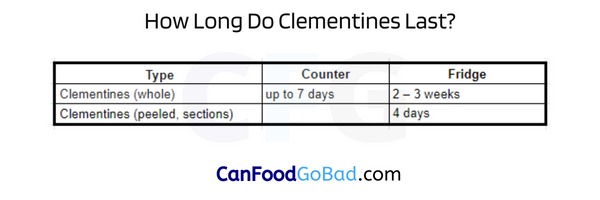How Long Do Clementines Last: Learn how long clementines last and how to tell when clementines go bad so you can be sure you’re not eating anything rotten, whether you use them in baking, eat them whole (excellent for lunches), or slice them up and add them to a dish.
Fortunately, it’s pretty simple to determine when a clementine has gone bad, and there are some storage suggestions to make sure they don’t go bad as quickly. Time to go and explore more about clementines. So let’s go and find out interesting facts regarding Clementines and their different components!
- Do Clementines Go Bad?
- How Long Do Clementines Last?
- How Long Do Clementines Last in the Freezer?
- Can Clementines Last Unpeeled For A Long Period?
- Ways To Store Clementines
- How Do You Know When Clementines Get Stale?
- Interesting Facts About Clementine
- What Can I Do with the Old Clementines?
- Do Clementines ripen faster in sunlight or shade?
- How do you store fresh Clementines?

Do Clementines Go Bad?
Yes, Clementines do indeed expire. Fruits include enzymes that continue to function during their whole period of storage. These enzymes will cause the fruits to degrade, which will result in browning, discolouration, and other problems. Additionally, mould and germs pose a threat. Instead of a clementine that is more firm and orange with smooth skin, these microorganisms will essentially devour the fruit.
How Long Do Clementines Last?
Clementines often last for 1 to 2 weeks, depending on how they are stored. The average person keeps their clementines at room temperature, where these clementines typically last seven days. As the process progresses, they will release more enzymes, and the cycle repeats itself until you have a clementine that is mouldy, discoloured, and squishy in all the wrong ways.
| Type | Counter | Fridge |
|---|---|---|
| Clementines (whole) | up to 7 days | 2 – 3 weeks |
| Clementines (peeled, sections) | 4 days |

How Long Do Clementines Last in the Freezer?
Clementines should last up to two weeks in the refrigerator. Even if some people dislike the flavour of cold clementines, storing them in a place that is reasonably chilly and dark, such as the refrigerator, will keep them fresh and out of the way of sunlight. Consider placing your clementines in the freezer to increase their shelf life! Clementines will keep in the freezer for around six to twelve months.
Can Clementines Last Unpeeled For A Long Period?
If you haven’t eaten your clementine yet after peeling it, it will keep for 1-2 days at room temperature and 2-4 in the fridge. Unpeeled clementines are less protected than peeled ones and are more prone to becoming mushy and drenched. In any case, you shouldn’t peel your clementines that long in advance. Most people just peel them when they’re ready to eat them because they’re so simple to peel. However, if you need to peel them in advance for a dish or to put them in a lunchbox, the day before or the day of is great.
Ways To Store Clementines
To let those clementines endure as long as possible, let’s discuss the clementine store. Your clementines can be stored in one of three ways.
Freezer
Your clementines are freezer-safe! Perhaps you purchased a lot of them during their season, which lasted from November to April, or perhaps you wish to utilise them year-round in other recipes like baking. Your clementines will last between six months and a year if you freeze them intact. Your clementines will keep for around 3 months if you freeze them unpeeled and split them into pieces. Simply chop and peel your clementines, then combine them in a freezer-safe bag or container.
Your clementines will survive for around a year if you freeze them in slices in simple syrup. To accomplish this, prepare a basic syrup for fruit preservation, then place cut and unpeeled clementine slices in the syrup in a freezer-safe container.
Refrigerator
Do clementines need to be refrigerated? is a common question. No, you can store them at room temperature; however, they will keep better in the refrigerator. It’s often recommended to place clementines in the crisper, which helps keep food items separate from other germs and moisture in the refrigerator while storing them in the fridge. Instead of keeping them separately, you can stack them together in the refrigerator; however, avoid crushing them with other foods.
Room Temperature
At room temperature, clementines do go bad, but you typically have 5 to 7 days before that happens. We placed them apart from other fruits in a fruit bowl with lots of air movement (sometimes gases from other fruits can speed up the spoiling process). To avoid clementines heating up in the sun and developing mould, try to store them out of direct sunlight. If you want to use all of your clementines within a week, this is the simplest method to keep them and will free up space in the refrigerator.
Read Similar:
How Do You Know When Clementines Get Stale?
When clementines go rotten, they exhibit a few telltale symptoms.
Wrinkled Skin
A fresh clementine will have tight, smooth skin with a few small pit scars. When you run your fingers across it, it feels smooth and silky, much like an orange peel from an advertisement. The skin on these clementines wrinkles and puckers in as they go rotten. It’s typically best to assume a clementine is terrible if you see this on it.
Loose Skin
The skin and fruit within a fresh clementine are very firmly bound together when you peel it. It will appear as though you are removing it from the apple directly. Clementines’ skin can become extremely flimsy and begin to rip away from the fruit within when it goes rotten. When peeling a clementine, you’ll be able to tell if it’s rotten since there will feel to be a space of air between the skin and the fruit. It’s time to remove the skin if it’s sagging, loose, or wrinkled.
Mold Growth
The easiest sign of poor clementine is mould development, which frequently occurs when the fruit approaches the end of its shelf life (especially if it has been left at room temperature or exposed to heat). You could also observe white or black patches in addition to the common blue mould. Even though the fruit inside the clementines appears to be “fine,” avoid eating mouldy ones.
Discolouration
It’s possible that you will not see any specific mould spores on the clementine peel, but if it looks anything other than brilliant orange or stained in any other manner, you should be concerned.

Interesting Facts About Clementine
Amongst the most prevalent and distinguishable uses of Nectarines, we have some unmatched facts to know regarding Nectarines. Do check out the following facts and let us know which one of them you liked the most:
- Vitamin C and other nutrients are abundant in clementines. Contraindications do exist, however, and clementines, like other citrus fruits, can be harmful to those who have gastrointestinal disorders. It is not advisable to take medications and clementines at the same time since the chemicals in clementines frequently multiply the effects of drugs.
- Tangerine juice and compote are made from clementine fruits as well as consumed fresh. These juices can be found in fruit salads and sweets, candied and added to brandy, frozen for sorbet, and blended with beverages. Clementines can also be used to make liqueurs. Clementine is used as a spice in rice, seafood, and chicken meals as well as sauces.
- Examine the fruit’s peel before selecting it. A fruit that has been laying about for a while or that is overripe may have a dried-out, sluggish, or even in some areas woody skin. Unripe clementines are hefty, have almost all green skin, and are particularly challenging to peel. When clementines have mildew, brown stains, or decayed sections, they are of low quality.
Go through the article on How Long Do Tangerines Last as well and become familiar with the storage tips, shelf life, etc.
FAQs on Clementine’s Storage Methods
1. What Can I Do with the Old Clementines?
Old clementines should not be eaten if you believe they have gone bad, but if they haven’t gone too far, you can leave them in your backyard for squirrels, deer, and birds. You may also attempt making marmalade out of them using clementines if they aren’t rotten but have merely become softer and soggier.
2. Do Clementines ripen faster in sunlight or shade?
Clementines ripen as a result of sunlight, warmth, and humidity. However, these circumstances speed up the over-ripening of ripe clementines. For two to seven days, keep. The majority of clementines may be kept at room temperature for up to two or three days.
3. How do you store fresh Clementines?
You might even be able to preserve the clementines in this way for a whole week if the fruit was in superb shape, to begin with, and the room’s surroundings are right. In a mesh bag, arrange the clementines. If possible, put all of the clementines in a mesh bag made of plastic.
Final Words
The crisper drawer of your refrigerator is typically the best spot to keep clementines. Having said that, there may be circumstances in which you’d like to keep the fruit in your freezer or at room temperature. To do so securely, you must adhere to the particular instructions we covered above. Bookmark our site to get updates on How Long Do Grapes Last and various fruits all in one place.